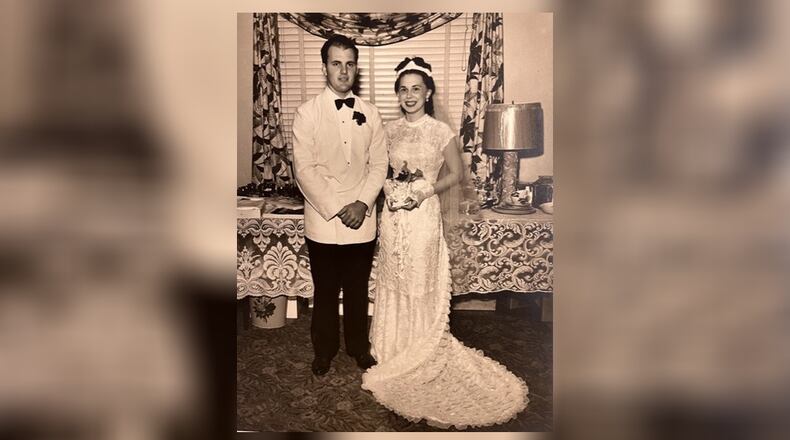It was in that atmosphere that Minola Hill and Eddie Bernardi plotted to announce their engagement on Valentine’s Day 1949.
Eddie, who served in the Navy, and Minola, who now lives at Springfield’s Oakwood Village, worked at a defense plant where she “patched up paint” on tachometers for airplanes.
In their 47 years together, both liked to tell the story of how they met in alley, which is technically true.
Because it was through a door off an alley that Minola’s business sorority (not affiliated with Purdue University) held its Halloween Party of 1948.
Minola’s friend, Bobbi Townley, had a date for it who brought Eddie, then a senior at Purdue.
The latter invited Minola for a drink afterwards. Four months later, as the holiday of love approached, it was no secret that likely to be married. The challenge for Eddie and Minola was to find a way to announce it that was “just nutty enough” to meet the high standards of the crowd they ran with.
So, on Feb. 14, they held a dinner party for 35. When they were all there, Eddie – who Minola says was “always in the middle of everything” -- announced their engagement by letting a cat out of a bag.
“The cat was scared to death,” she recalled, “but everybody (save for the cat) got a kick out of it.”
Eddie, who spent his career rep with Upjohn pharmaceuticals, been gone since 1994, when the couple lived Santa Monica Drive in Springfield.
But tomorrow, on her 100th birthday, Minola will celebrate, using as the event’s centerpiece the most important keepsake of her life – the wedding dress she and her mother designed for the big day, June 19, 1949.
“I wanted so bad to be able to show I could wear it after 75 years,” Minola said. But I couldn’t get the zipper up.”
And she didn’t want to risk making alterations that might scar a dress that represents the fabric of both her personal and productive lives.
“My mother’s sisters were always sewing, quilting and making things,” she said, and by taking in sewing from people of means, “my mother learned how the good stuff was made.”
Minola learned at her elbow.
Even before her 4-H sewing club, she carried her gender’s preferred tools of the era in “a box with all that stuff in it.”
All that was left was for Hollywood to give her an eyeful of what magic that could be made with a thread, a needle and a creative mind.
“My parents used to play cards every Sunday afternoon, and we kids had to go to the movies,” she said.
There Minola saw Betty Grable, Fred Astaire and Ginger Rogers, along with the cavalcade of extravagant gowns as beautiful as the actresses who wore them in the outsize production numbers of the time.
“I always wanted to be one of those designers that did those costumes,” she said.
After high school, she endured a job at the telephone company and a stretch at business school. Then, while working in a dress shop, she saw a notice about the Vogue School of Dress and Design in Chicago.
“I read it in a magazine, told my mother about it, and she managed to get me up there.”
“I lived on the South Side (and) took the train to school every morning.” The cutting - (and -stitching) edge school offered “all kinds of programs: fabric analysis, drawing, modeling.
“I had to take muslin and drape it over a form (to) learn to make a pattern.”
Two years later, she went to work at her mother’s corset shop, and together they started Minola Ann Originals.
While there, was called to Fort Wayne to help a designer with last-minute costume design and production for a play. “And my mother had to come up to help.”
As a result, Minola began brainstorming about the dress she would design, and her mother would help her make before the cat was even put in the bag.
“it’s been so long ago I can’t remember how it all started,” she said. “I just had it in my mind because I was always drawing something. And I happened to have this lace material.”
“I wanted it beaded, so each part has beads around it, and we didn’t have Wal-Mart in those days, so Had to go to Chicago to get them.”
There were so many to attach that “toward the end, some of the neighbors helped.”
Meanwhile, her mother was occupied making “probably 100 yards of ruffles” out of a new material called nylon.
“It had a train on it made of ruffles,” she said, “and a flounce on the bottom, which was unusual. When you walk it kind of flips out and gives you room to walk.” Minola cleverly fashioned a strap by which she could hold up the train so it wouldn’t need a tender. For ease of dancing, she made the train detachable.
Made in the ball gown style, the dress was practical because she could use it for other occasions.
Including her 100th birthday party.
About the Author

